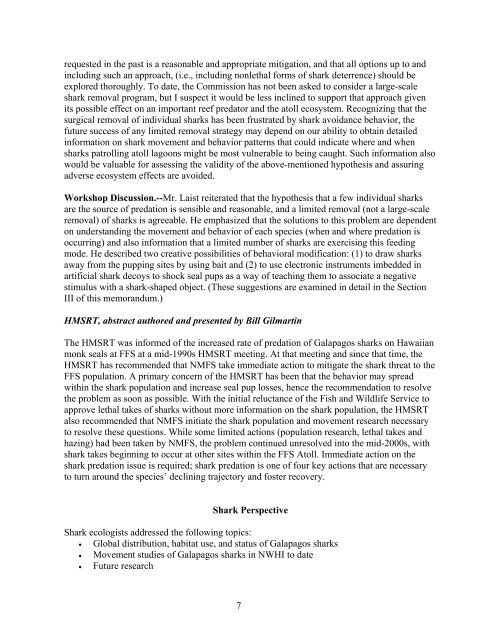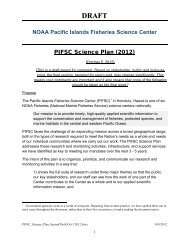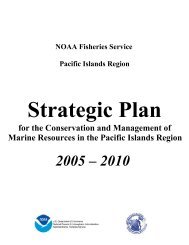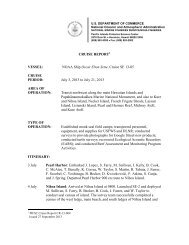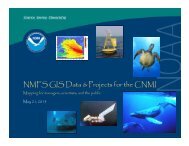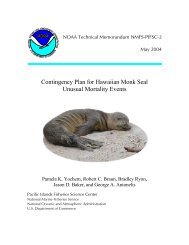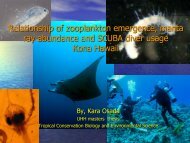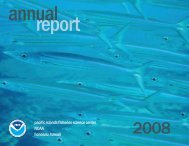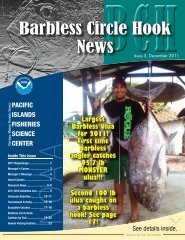Shark Predation on Hawaiian Monk Seals - Pacific Islands Fisheries ...
Shark Predation on Hawaiian Monk Seals - Pacific Islands Fisheries ...
Shark Predation on Hawaiian Monk Seals - Pacific Islands Fisheries ...
Create successful ePaper yourself
Turn your PDF publications into a flip-book with our unique Google optimized e-Paper software.
equested in the past is a reas<strong>on</strong>able and appropriate mitigati<strong>on</strong>, and that all opti<strong>on</strong>s up to and<br />
including such an approach, (i.e., including n<strong>on</strong>lethal forms of shark deterrence) should be<br />
explored thoroughly. To date, the Commissi<strong>on</strong> has not been asked to c<strong>on</strong>sider a large-scale<br />
shark removal program, but I suspect it would be less inclined to support that approach given<br />
its possible effect <strong>on</strong> an important reef predator and the atoll ecosystem. Recognizing that the<br />
surgical removal of individual sharks has been frustrated by shark avoidance behavior, the<br />
future success of any limited removal strategy may depend <strong>on</strong> our ability to obtain detailed<br />
informati<strong>on</strong> <strong>on</strong> shark movement and behavior patterns that could indicate where and when<br />
sharks patrolling atoll lago<strong>on</strong>s might be most vulnerable to being caught. Such informati<strong>on</strong> also<br />
would be valuable for assessing the validity of the above-menti<strong>on</strong>ed hypothesis and assuring<br />
adverse ecosystem effects are avoided.<br />
Workshop Discussi<strong>on</strong>.--Mr. Laist reiterated that the hypothesis that a few individual sharks<br />
are the source of predati<strong>on</strong> is sensible and reas<strong>on</strong>able, and a limited removal (not a large-scale<br />
removal) of sharks is agreeable. He emphasized that the soluti<strong>on</strong>s to this problem are dependent<br />
<strong>on</strong> understanding the movement and behavior of each species (when and where predati<strong>on</strong> is<br />
occurring) and also informati<strong>on</strong> that a limited number of sharks are exercising this feeding<br />
mode. He described two creative possibilities of behavioral modificati<strong>on</strong>: (1) to draw sharks<br />
away from the pupping sites by using bait and (2) to use electr<strong>on</strong>ic instruments imbedded in<br />
artificial shark decoys to shock seal pups as a way of teaching them to associate a negative<br />
stimulus with a shark-shaped object. (These suggesti<strong>on</strong>s are examined in detail in the Secti<strong>on</strong><br />
III of this memorandum.)<br />
HMSRT, abstract authored and presented by Bill Gilmartin<br />
The HMSRT was informed of the increased rate of predati<strong>on</strong> of Galapagos sharks <strong>on</strong> <strong>Hawaiian</strong><br />
m<strong>on</strong>k seals at FFS at a mid-1990s HMSRT meeting. At that meeting and since that time, the<br />
HMSRT has recommended that NMFS take immediate acti<strong>on</strong> to mitigate the shark threat to the<br />
FFS populati<strong>on</strong>. A primary c<strong>on</strong>cern of the HMSRT has been that the behavior may spread<br />
within the shark populati<strong>on</strong> and increase seal pup losses, hence the recommendati<strong>on</strong> to resolve<br />
the problem as so<strong>on</strong> as possible. With the initial reluctance of the Fish and Wildlife Service to<br />
approve lethal takes of sharks without more informati<strong>on</strong> <strong>on</strong> the shark populati<strong>on</strong>, the HMSRT<br />
also recommended that NMFS initiate the shark populati<strong>on</strong> and movement research necessary<br />
to resolve these questi<strong>on</strong>s. While some limited acti<strong>on</strong>s (populati<strong>on</strong> research, lethal takes and<br />
hazing) had been taken by NMFS, the problem c<strong>on</strong>tinued unresolved into the mid-2000s, with<br />
shark takes beginning to occur at other sites within the FFS Atoll. Immediate acti<strong>on</strong> <strong>on</strong> the<br />
shark predati<strong>on</strong> issue is required; shark predati<strong>on</strong> is <strong>on</strong>e of four key acti<strong>on</strong>s that are necessary<br />
to turn around the species’ declining trajectory and foster recovery.<br />
<str<strong>on</strong>g>Shark</str<strong>on</strong>g> Perspective<br />
<str<strong>on</strong>g>Shark</str<strong>on</strong>g> ecologists addressed the following topics:<br />
Global distributi<strong>on</strong>, habitat use, and status of Galapagos sharks<br />
Movement studies of Galapagos sharks in NWHI to date<br />
Future research<br />
7


